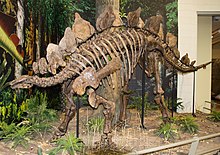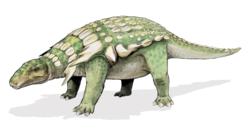Portal:Dinosaurs
IntroductionDinosaurs are a diverse group of reptiles of the clade Dinosauria. They first appeared during the Triassic period, between 243 and 233.23 million years ago (mya), although the exact origin and timing of the evolution of dinosaurs is a subject of active research. They became the dominant terrestrial vertebrates after the Triassic–Jurassic extinction event 201.3 mya and their dominance continued throughout the Jurassic and Cretaceous periods. The fossil record shows that birds are feathered dinosaurs, having evolved from earlier theropods during the Late Jurassic epoch, and are the only dinosaur lineage known to have survived the Cretaceous–Paleogene extinction event approximately 66 mya. Dinosaurs can therefore be divided into avian dinosaurs—birds—and the extinct non-avian dinosaurs, which are all dinosaurs other than birds. Dinosaurs are varied from taxonomic, morphological and ecological standpoints. Birds, at over 11,000 living species, are among the most diverse groups of vertebrates. Using fossil evidence, paleontologists have identified over 900 distinct genera and more than 1,000 different species of non-avian dinosaurs. Dinosaurs are represented on every continent by both extant species (birds) and fossil remains. Through the first half of the 20th century, before birds were recognized as dinosaurs, most of the scientific community believed dinosaurs to have been sluggish and cold-blooded. Most research conducted since the 1970s, however, has indicated that dinosaurs were active animals with elevated metabolisms and numerous adaptations for social interaction. Some were herbivorous, others carnivorous. Evidence suggests that all dinosaurs were egg-laying, and that nest-building was a trait shared by many dinosaurs, both avian and non-avian. (Full article...) Selected articleThescelosaurus is a genus of small ornithopod dinosaur known from Upper Cretaceous rocks of western North America. It belonged to the last dinosaurian fauna of North America before the Cretaceous–Paleogene extinction event at approximately 66 million years ago, living alongside dinosaurs such as Tyrannosaurus and Triceratops. This common genus was described from a specimen discovered in 1891, but not unpacked and studied until the 1910s. These circumstances suggested the names of the genus and type species T. neglectus, which roughly translate to "godlike, wondrous, or marvelous neglected lizard". Thescelosaurus is best known from several partial skeletons representing three species: T. neglectus, T. assiniboiensis, and T. garbanii. One specimen unearthed in 1993 was initially thought to include a preserved heart, but later study found the object is probably a concretion. Thescelosaurus was a bipedal animal with a relatively long pointed skull and robust limbs. Typical individuals measured on the order of 2.5 to 4.0 metres (8.2 to 13.1 ft) long. It was probably primarily herbivorous and may have preferred to live near streams. (see more...) TopicsSubcategoriesSelected image
Photo credit: User:LadyofHats Did you know...
Things you can do
Proposed deletions
Peer reviews
Articles to be merged
Articles to be split
Related content
Associated WikimediaThe following Wikimedia Foundation sister projects provide more on this subject:
Discover Wikipedia using portals |





























